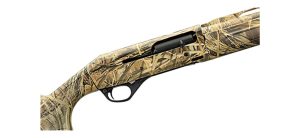History of the Semi-Automatic Shotgun
The History of the Semi-Automatic Shotgun
Shotguns have played a significant role in the world of firearms since their invention in the 17th century. Originally, shotguns were manually operated, requiring the shooter to manually load each shell into the chamber. However, as technology progressed, the semi-automatic shotgun was introduced, revolutionizing the way firearms were used. In this article, we will delve into the fascinating history of semi-automatic shotguns, exploring their evolution, revolutionary advancements, and modern marvels.

The Evolution of Shotguns: From Manual to Semi-Automatic
The early years of shotgun development were marked by manual operation, where shooters had to load each shell individually into the chamber. This process was time-consuming and limited the shooter’s ability to quickly fire successive shots. However, as the industrial revolution took hold in the late 19th century, advancements in firearm design paved the way for the creation of semi-automatic shotguns.
The first major breakthrough came in 1898, when John Moses Browning, a legendary firearms designer, patented the first semi-automatic shotgun. His design featured an innovative gas-operated system, allowing the shotgun to automatically cycle through successive shots without requiring the shooter to manually reload. This groundbreaking invention marked the beginning of a new era for shotguns, as it provided increased firepower and improved ease of use.

Revolutionary Advancements: Semi-Automatic Shotguns Enter the Scene
Following Browning’s patent, several firearm manufacturers began producing and refining semi-automatic shotguns. One of the most notable advancements during this period was the introduction of the Browning Auto-5 in 1902. This semi-automatic shotgun became immensely popular and remained in production for almost a century. Its reliable operation and iconic humpback design made it a favorite among hunters and sport shooters alike.
In the early 20th century, other firearm manufacturers like Remington and Winchester joined the race to develop their own semi-automatic shotguns. These companies introduced models such as the Remington Model 11 and the Winchester Model 1911, further propelling the popularity and use of semi-automatic shotguns.

Modern Marvels: Unveiling the Fascinating History of Semi-Automatic Shotguns
As technology advanced, so did the features and capabilities of semi-automatic shotguns. In the mid-20th century, advancements such as improved gas systems, lighter materials, and increased magazine capacities were introduced. These developments resulted in faster cycling rates, reduced recoil, and enhanced overall performance.
Today, semi-automatic shotguns have become a staple in various fields, including hunting, sport shooting, and law enforcement. Modern semi-automatic shotguns offer a wide range of features, including adjustable stocks, extended magazine tubes, and interchangeable chokes, providing shooters with versatility and customization options.

The Evolution Continues
The history of semi-automatic shotguns is a testament to the ceaseless advancements in firearm technology. From manual operation to the introduction of gas-operated systems, semi-automatic shotguns have come a long way. As the demand for faster and more efficient firearms grows, the future of semi-automatic shotguns holds promise for further innovation and improved performance. Whether it’s for hunting, competitive shooting, or self-defense, semi-automatic shotguns continue to play a vital role in the firearms industry, combining history and innovation into one powerful package.
# # #


Comments